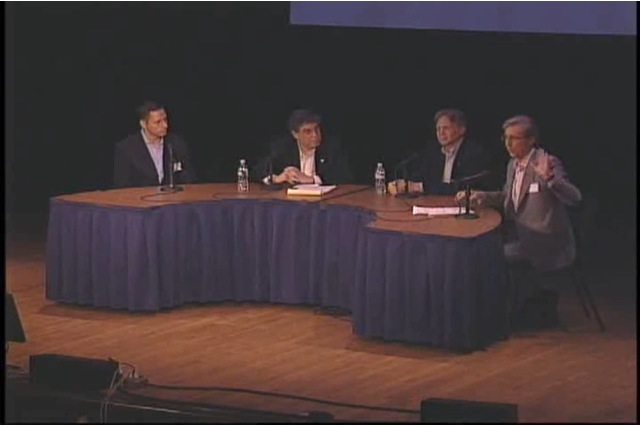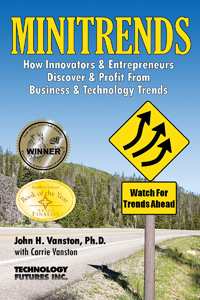Business Model Trends – The Good, The Bad, and The Ugly
March 22, 2011
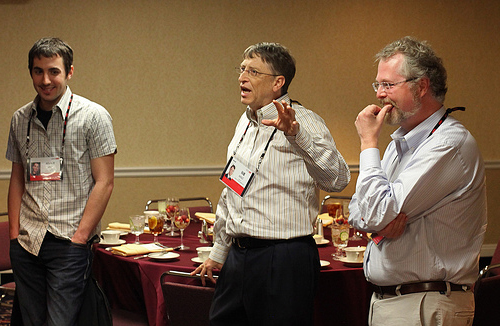
Kevin Rose of Digg, Bill Gates of Microsoft, and Nathan Myhrvold of Intellectual Ventures at the TED Conference (Photo courtesy of Steve Jurvetson).
Two days before an earthquake measuring 9.0 on the Richter scale struck Japan, resulting in a devastating tsunami and near meltdown at the Fukushima nuclear power plant, we wrote on this blog about “the growing interest in nuclear power” as an alternative to coal fired power plants.
Oops!
While nuclear power-generating facilities have been greatly improved since the Fukushima reactors were built — and the prospects for nuclear energy in the future are still bright — the timing is bad. The prospects for nuclear energy in the short term have dimmed as the costs associated with using that technology are being recalculated.
That wasn’t the only thing wrong with my blog post. A reader called my attention to the case against venture capitalist Nathan Myhrvold’s company, Intellectual Ventures. Myhrvold is the former chief technology officer of Microsoft whose new company invests in technology rather than investing in companies. Intellectual Ventures buys the rights to patents it likes, then markets those patents to other firms. Or does it?
According to Mike Masnick, the prolific and outspoken editor of TechDirt, Myhrvold’s venture is not based on marketing patents but on “shaking down” companies by suing anyone using its patents without permission. Masnick accuses Intellectual Ventures of disguising its true business model by using shell companies to file the lawsuits:
[Intellectual Ventures] had decided to protect its brand name by getting other companies or creating those companies itself, giving the patent to those other companies that no one had ever heard of, and having them sue.
Ouch!
While we did praise Myhrvold’s business plan on this blog, his method for picking technologies to invest in was our focus, not his manner of collecting on those investments. However, without beating up on ourselves too much, we should point out that another company with a strikingly similar business plan has been the recipient of tremendous admiration in the media these past few weeks.
I’m speaking of ARM, the technology company behind the low-heat computer chips used in Apple’s iPhone and iPad, along with many other smartphones and tablets. The company is not bashful about its creative structure:
ARM has an innovative business model. Instead of bearing the costs associated with manufacturing, we license our technology to a network of partners, mainly leading semiconductor manufacturers and OEMs. These partners utilise our designs to create smart, low energy chips suitable for modern electronic devices.
This structure — licensing technology rather than manufacturing it — has led to a gross margin for ARM of 94%. With revenue of $631 million in 2010, ARM had a profit of $593 million. You have to envy that ratio, no matter what business you’re in.
ARM’s business model is similar to Intellectual Venture’s stated mission, yet while Myhrvold is the recipient of scorn from TechDirt and others, ARM is getting nothing but love these days. Renown technology strategist, Michael J. Fern, gushes over ARM’s business model, saying it confers “three significant advantages over Intel.”
The Wall Street Journal joined the praise parade, with University of Chicago-trained economist and new “Heard on the Street” columnist, Rolfe Winkler, noting “ARM… doesn’t have to deal with manufacturing costs or the risks of holding inventory. It’s a deeply profitable business.”
The best take on ARM’s business model, from a Minitrends perspective, comes from the recent article by Om Malik at the influential blog, GigaOM. In a post critical of Twitter’s business model, the highly-respected tech journalist compares and contrasts the business models of half-a-dozen tech companies, including Xerox, Apple, Google, and ARM. Relying heavily on the work of business guru Alex Osterwalder, Malik concludes that “the business model innovation is what turns great products into fearsome companies.”
Sometimes, the most beautiful business models can turn ugly down the road. I was teaching a workshop once when a perplexed attendee kept interrupting with questions. “How do you generate sales,” he asked. “I don’t have sales,” I answered, “I only have expenses. All I have to do is cover my expenses.”
I was describing the workings of a technology startup that made videos of businesses without charging those businesses. Costs were recouped by finding sponsors to cover the expenses. The fellow in the back of the room couldn’t understand the business model and, as it turns out, neither could investors or sponsors. An early online video play, the company died in 2008 for lack of revenue.
The clever idea of yesterday can seem brilliant or stupid a few years — or even a few days — later. That’s why, for your own Minitrends Adventure, we recommend spending as much time thinking about the business model as you do about the services or goods being sold.
STEVE O’KEEFE
News Editor, Minitrends Blog
Source: “Nathan Myhrvold on Uncovering and Investing in Technology Trends,” Mintrends Blog, March 9, 2011
Source: “Nathan Myhrvold’s Intellectual Ventures Using Over 1,000 Shell Companies To Hide Patent Shakedown,” TechDirt, Feb. 17, 2010
Source: “ARM Disrupting Intel with its Business Model?,” FernStrategy, March 10, 2011
Source: “Getting an ARM Up on Intel,” The Wall Street Journal, March 17, 2011
Source: “What Is Twitter’s Problem? No, It’s Not the Product,” GigaOM, March 8, 2011
Photo courtesy of Steve Jurvetson, used under its Creative Commons license.
Nathan Myhrvold on Uncovering and Investing in Technology Trends
March 9, 2011
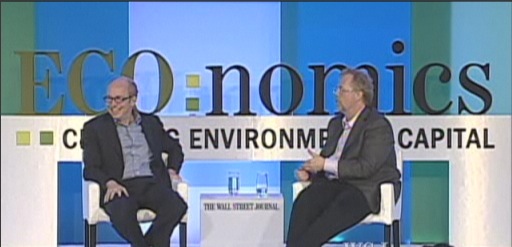
The Wall Street Journal's Alan Murray (left) interviews technology investor and former Microsoft chief technology officer, Nathan Myhrvold, at the ECO:nomics Conference. Click for video.
The Wall Street Journal recently concluded its fourth annual conference on environmental economics at the Bacara Resort in Santa Barbara, California. Dubbed “ECO:nomics,” the Journal‘s invitation-only event offers a casual program of interviews and audience Q&A with corporate CEOs, venture capitalists, and government leaders.
Some of the technology trends revealed at this year’s conference include:
- Growing interest in nuclear power as a clean alternative to coal-fired power plants. Veteran technology writer, John Letzing, describes on The Wall Street Journal’s MarketWatch a dustup between Sierra Club chairman Carl Pope and Breakthrough Technology’s Michael Shellenberger.
- Growing disillusionment with electric cars. Ford Motor Company chairman, Bill Ford, sounded pessimistic about the future of battery-powered cars, according to Ovidiu Sandru at The Green Optimistic.
- Continued divisiveness over issues of global warming and climate change. Brandon Fastman at the Santa Barbara Independent describes the very different stances taken by politicians and corporate executives at the conference.
One of the highlights for those interested in Minitrends was Alan Murray’s interview with venture capitalist and former Microsoft chief technology officer, Nathan Myhrvold. The restless inventor shared the unique way in which his firm, Intellectual Ventures, invests in startups:
We invest in invention. Venture capitalists invest in companies…We try to invest in the actual idea…Someone will have already invented something; they won’t know what to do with it. We’ll take a controlling investment in that idea and maybe we can figure out what to do with it.
This is a different approach than most venture capitalists use: buying the technology rather than the organization. Myhrvold’s method of finding Minitrends is not so unique: “We’ll bring typically six to 10 people…in a room, and we’ll start brainstorming solutions…Usually, we come up with some solution, but often it’s not to the problem we posed. We then go through a process we call triage: Which of the ideas we generated are really worth pursuing?”
The triage process Myhrvold describes is similar to the vetting of Minitrends described in the book, MINITRENDS, by John and Carrie Vanston, a guide to identifying and exploiting business trends that are likely to bear fruit in two-to-five years.
The Wall Street Journal has been stingy making video or transcripts of the ECO:nomics conference available online. Such archives are usually fertile sources for Minitrends research. However, they have made one video segment with Nathan Myhrvold available, along with the newspaper’s “special report” coverage of ECO:nomics 2010 (PDF) and 2011 (website).
One final trend worth noting. Previously on this blog, we’ve mentioned the fashion trend that venture capitalists don’t wear neckties. It appears this year the trend has spread to CEOs. Virtually none of the CEOs speaking at the ECO:nomics conference wore ties, in contrast to just a few years ago, when the majority did. It seems the only holdouts in the necktie department are elected officials and other bureaucrats. Chief executives of the world, untie!
STEVE O’KEEFE
News Editor, Minitrends Blog
Source: “The Next Smart Thing,” The Wall Street Journal, March 7, 2011
Source: “Environmentalists spar over nuclear power,” MarketWatch, March 4, 2011
Source: “Ford Giving Up on EVs? Not Quite,” The Green Optimistic, March 7, 2011
Source: “Making Green Green,” Santa Barbara Independent, March 7, 2011
Image courtesy of The Wall Street Journal, used under fair use: commentary.
Accenture IT Report Encourages Businesses to Lose Control
February 22, 2011
 Is your business ready to lose control? That appears to be the direction of enterprise computing, according to a new set of predictions just released by management consulting powerhouse, Accenture.
Is your business ready to lose control? That appears to be the direction of enterprise computing, according to a new set of predictions just released by management consulting powerhouse, Accenture.
In the free report, Accenture Technology Vision 2011, Accenture’s information technology (IT) team, led by Kevin Campbell, chief executive of the company’s technology group, reviewed such sources as the subjects of keynote speeches at technology conferences, the types of projects receiving venture capital funding, and the predictions of well known IT experts. These sources are similar to those John and Carrie Vanston recommend consulting when analyzing the viability of trends in their book, MINITRENDS. The Accenture report arrives at a short list of eight trends that are transforming IT.
Accenture sees “a world of IT that barely resembles what enterprise computing looks like today,” according to Gavin Michael, Accenture’s managing director of research and development, as quoted by TMCnet reporter, Rajani Baburajan. “IT is no longer in a support role. Instead, it is front and center driving business performance and enriching people’s lives like never before,” Michael said.
Accenture sees three major rivers running through its predictions:
- Greater Distribution of Data: “Data is dispersed across many more locations, and under the control of far more owners.”
- The Separation of Software and Hardware: “Technology today enables decoupling of entities and layers once deemed inseparable.”
- The Meteoric Rise of Analytics: “Analytics will become the super-tool with which to drive more agile and effective decision-making.”
You have to be something of a mindreader to parse the jargon of the report and glean the pearls of wisdom it contains, but they are there. Accenture sees decentralization at the core of technology trends, such as cloud computing, which we have frequently covered on this blog.
The report’s insight that IT security needs to move from a “fortress mentality” to a layered and distributed series of security checks is prescient, as is the awareness that greater automation in security and the ability of software to handle “noise” will improve results. Imagine how the technology behind IBM’s Watson (the new Jeopardy champion) will enable computers to understand natural language and anticipate security breaches instead of waiting for an attack.
The Accenture report, like most similar surveys, sees the rise of the social platform in enterprise computing. The website will no longer be the primary connection point between an organization and its constituents. Companies will have to set up shop where the consumer is — on sites such as Facebook and Netflix — rather than waiting for the consumer to come to them.
The report concludes with this powerful insight: The primary role of IT in the past has been to reduce an organization’s costs; in the future, it will be to enhance the user experience. The authors of the report foresee technology that goes beyond Apple Computer’s famously intuitive user experience to something that instantly and seamlessly shapes itself to the unique characteristics of the user.
Accenture’s vision is at once thrilling and unsettling. Organizations will have to move out of their bunkers, distributing their computing resources and allowing users to take control. Like a fast-paced, high-tech amusement ride, it’s going to be scary but enjoyable for those entities able to loosen up and cede control of their IT resources to the audiences they are charged with serving.
STEVE O’KEEFE
News Editor, Minitrends Blog
Source: “Accenture Technology Vision 2011” (PDF), Feb. 7, 2011
Source: “Accenture Maps Eight Trends That Will Drive Future of IT,” infoTech Spotlight, Feb. 9, 2011
Image by Mulad (Michael Hicks), used under its Creative Commons license.
“Nine Emerging Minitrends to Watch” by Dr. John H. Vanston, MINITRENDS Author & Chairman, TFI
December 28, 2010
 Happy holidays to Minitrends blog readers! We appreciate your interest in our Minitrends posts and activities. As we start the new year, there will be many opportunities for those who are alert enough to recognize emerging trends, perceptive enough to realize their importance, and clever enough to take advantage of them. Here I suggest nine Minitrends—emerging trends that will become significantly important within 2-5 years, but are not yet generally recognized—that are well worth examining for possible action by those ambitious individuals who seek to start new ventures or keep existing businesses innovative and competitive.
Happy holidays to Minitrends blog readers! We appreciate your interest in our Minitrends posts and activities. As we start the new year, there will be many opportunities for those who are alert enough to recognize emerging trends, perceptive enough to realize their importance, and clever enough to take advantage of them. Here I suggest nine Minitrends—emerging trends that will become significantly important within 2-5 years, but are not yet generally recognized—that are well worth examining for possible action by those ambitious individuals who seek to start new ventures or keep existing businesses innovative and competitive.
Unlike megatrends, Minitrends are of a scope and importance to offer attractive opportunities to individual entrepreneurs, decision-makers in small and mid-size businesses, innovative thinkers in large companies, and adventuresome investors. In my new book, MINITRENDS: How Innovators & Entrepreneurs & Discover & Profit From Business & Technology Trends, I categorize the nine Minitrends below to those most applicable to different-sized groups. (In the book, I also discuss the background, current trends, and business opportunities of each of these Minitrends in more depth.) I do the same categorization below, but in reality, all provide opportunities to perceptive individuals in all-sized businesses.
Minitrends Particularly Applicable to Individuals or Small Groups of Individuals:
1. Expanding Involvement in Virtual Worlds (Free Virtual Worlds book excerpt available):
Virtual worlds are computer-based platforms that allow participants to engage in a wide range of real-world type activities, e.g., buying and building virtual world property, furnishing virtual world homes and offices, producing and selling virtual world goods, traveling, taking part in virtual world social activities such as parties and fundraisers, and communicating with other participants. Increasingly, virtual worlds are being used for educational purposes, product advertisements, new product modeling and testing, identification of new markets, and uncovering unexpected problems with new marketing programs.
2. Support for People Working at Home:
Although an increasing number of people are now conducting all or part of their work at home, these people often find they miss interacting with others and miss the convenience of facilities, equipment, and administrative support. A number of solutions are emerging to better meet the needs and desires of people working at home, including small offices or meeting rooms that can be rented by the day or the hour; chat rooms where people can meet informally to discuss ideas; semiformal groups that meet regularly to establish person-to-person interactions; and temporary support staffs organized to provide administrative assistance as needed.
3. Expanding Capabilities of Advanced Websites:
Although the World Wide Web had proven to be extremely popular, many believed a more interactive platform that took advantage of the Web’s power to communicate would be desirable (Web 2.0). Programmers are now expanding the capabilities of the Web to substitute computer activities for human activities, particularly activities that are repetitive, burdensome, and uninteresting (Web 3.0). Many believe Web 3.0 will eventually lead to effective artificial intelligence that can interact with humans in natural language.
Minitrends Particularly Applicable to Small and Medium-Size Companies:
4. Increasing Interest in Privacy:
Recent advances in technology, together with an increasing willingness of many to make personal information more easily available are threatening traditional concepts of privacy in terms of messaging, personal profiles, and identity. Techniques for countering these invasions of privacy, such as personal caution, technology aids, and group action are now being developed.
5. New Approaches to Giving and Receiving Advice:
Individuals and organizations commonly seek expert advice when making important decisions. In providing such advice, large consulting firms with large, multidisciplinary staffs, well-structured processes and procedures, huge computer capabilities, and long-standing reputations have traditionally had a major advantage. However, the ever-increasing power and ubiquity of information gathering, processing, and communicating technologies, small and medium-size consulting groups are often able to give more focused, timely, and user-friendly advice than the larger firms.
6. Evolution of Meaningful Maturity:
The twin trends of increasing life spans and decreasing retirement ages have caused a steady increase in retirement years. Because of social, personal interest, and/or financial reasons, many older individuals are either staying in their jobs longer or returning to the workforce. Their ability to utilize their experience, skills, and dedication effectively will depend on their current capabilities, their desires, and open opportunities to those willing to assist them.
Minitrends Particularly Applicable to Large Companies:
7. Advances in Digital Manufacturing:
Advanced digital manufacturing (ADM) processes build complex, custom-made parts by the addition of successive layers of material rather than traditional machining processes that cut, bend, and machine a part from stock material. The processes allow quicker production of prototypes and small production runs at a much lower cost. Recent ADM advances, including improved yield rates, reduced time-to-market, increasing variety of materials, and advances in 3D modeling software, have made ADM processes increasingly attractive to many manufacturers.
8. Increasing Electricity Use in Manufacturing:
The characteristics of electric power, such as high power density, no heat transfer medium requirements, controlled energy distribution, reduced material waste, and less environmental impacts, provide a number of benefits to manufacturing processes. Its use, however, has been limited by its relatively high cost. A number of factors, including advances in control technologies, changing customer needs, global competition, and increasing concern about the environment, are driving an increasing growth in the use of electricity in industrial processes.
9. New Applications of Nanotechnology:
When many substances are reduced to nano-size (100 nanometers or less) they often exhibit very different physical, electrical, chemical, and optical properties from the same substance at macro-size. These new properties often provide very unique and useful characteristics to nano-materials that can be used in a wide range of practical applications, such as cancer treatment, very high strength materials, special electronic systems, and water purification. Improved production techniques, decreased costs, and growing experience and understanding are increasing the practical applications of nanotechnologies
Minitrend involvement can give you a way to separate yourself from your colleagues and contemporaries. It provides a means for materially improving your business situation, your financial standing, and your personal satisfaction. I hope the Minitrends listed above will assist you or inspire you to launch your own exciting, profitable Minitrend Adventure that allows you to utilize your imagination, your logic, your innovative nature, and your basic good sense in the coming year.
Copyright 2011. Please feel free to reprint this article in whole or part with due credit to: “by Dr. John H. Vanston, MINITRENDS Author and Chairman, Technology Futures, Inc.” Thanks!
How Large Organizations Foster Innovation
December 14, 2010

An expansive new study just released by the Network for Business Sustainability provides valuable suggestions for executives in large organizations about how to keep their companies innovative and competitive.
The report, “Embedding Sustainability in Organizational Culture,” involved reviewing over 13,000 academic and industrial studies, then narrowing these down to 179 primary sources which were synthesized to extract common principles and best practices.
The issue of how to spur creativity in large organizations was a driving motivation for the new book, MINITRENDS. Author John H. Vanston, Ph.D., a nuclear engineer, university professor, and chairman of the technology forecasting firm, Technology Futures, Inc., is often called upon by large businesses to help them predict the future. These big companies want to ride technology trends, not be run over by them.
It’s one thing to know what’s coming, and another to be able to adjust to it. The new report from the Network for Business Sustainability is chock-full of ideas for keeping large organizations from getting stuck. It contains both the principles of innovation and copious examples of clever ways big companies have found to stay nimble. Here are some suggestions culled from the 74-page report:
- Remove barriers to teamwork and collaboration through the abolition of separate dining rooms for managers and line employees.
- Support an innovation culture through small gestures of recognition. At Bank of America, a small pin presented by high-level management “gave encouragement to employees who enacted the organization’s values and refocused management styles toward promoting and supporting these values.”
- The Ethical Corporation begins every meeting with a quick success story. Storytelling is used to create the “true believers and adherents” essential for embedding innovation. These stories help teach team members new ways of thinking and doing things.
- Include employees in developing team mission statements. This helps employees “build a sense of collective ownership, commitment, and focus and, through this, a culture of innovation.”
- Engage suppliers, customers, and even community representatives in dialogue about innovation. “Organizations must consider the entire supply chain and process, where suppliers and vendors are seen as partners co-designing and co-creating ideas and sustainability innovations.”
- Senior management must nurture feedback channels to “create a safe place for bold ideas to emerge.” The authors suggest that it is not enough to provide a feedback mechanism, but that senior management must actively solicit feedback through those channels and hold regularly-scheduled meetings to review suggestions.
- Innovation challenges, involving deadlines, recognition, and financial rewards, have been effective spurring innovation in many companies.
The study was written by Stephanie Bertels, PhD., an assistant professor at Simon Fraser University. She has made the results available, at no charge, in two different formats:
- A Systematic Review of the Body of Knowledge ( 74-page PDF)
- A How-To Guide for Executives (20-page PDF)
For those companies wishing to remain innovative, and for chief executives concerned about the future of their organizations when they leave, I would also recommend the book, MINITRENDS. If we have focused on entrepreneurs and small businesses here on this blog, that’s because innovation in large organizations often is the result of employees cultivating an entrepreneurial mindset and the organization acting like a venture capitalist in support of those individual efforts.
Fully one-third of MINITRENDS is devoted to fostering creativity in large organizations. The book is inspiring to individual employees and provides them with a set of skills for identifying and qualifying trends that show promise for profitable development in the near future. It should be required reading in organizations that hope to outlive their founders.
STEVE O’KEEFE
News Editor, Minitrends Blog
Source: “Embedding Sustainability in Organizational Culture” (PDF), Network for Business Sustainability, December 2010
Image courtesy of the Network for Business Sustainabilty, used under Fair Use: Reporting.
IDC Sees Perfect Storm in Portable Computing
December 8, 2010

On December 2, International Data Corporation (IDC), the giant IT research firm out of Framingham, Massachusetts, released its annual predictions for IT in the coming year. The firm is forecasting a perfect storm for IT: a combination of cloud computing, mobile computing, and social networking that threatens to consign desktop PCs to the storage closet.
The author of the survey is IDC’s chief analyst, Frank Gens, who leads IDC’s 1,000 analysts in 110 countries in tracking IT trends. Summarizing this year’s report, Gens sees a nearly complete transformation in the dominant computing platform:
What really distinguishes the year ahead is that these disruptive technologies are finally being integrated with each other — cloud with mobile, mobile with social networking, social networking with ‘big data’ and real-time analytics. As a result, these once-emerging technologies can no longer be invested in, or managed, as sandbox efforts around the edges of the market. Instead, they are rapidly becoming the market itself and must be addressed accordingly.
As the IDC report ripples through the Internet, different players are examining what it means for the future of computing. At ComputerWorld, Sharon Gaudin comments on the surge in social networking, suggesting that business startups will stop building expensive and complicated websites and opt for free Facebook pages instead.
Anuradha Shukla at TechWorld is enthusiastic about IDC’s upbeat predictions for IT expenditures. The report forecasts a 5.7% increase in outlays over 2010, to $1.6 trillion worldwide. IDC sees half of that spending coming from emerging market countries shrugging off the recession.
At PC World, Patrick Thibodeau focuses on IDC’s prediction that shipments of apps-enabled mobile devices — smartphones and tablets — will surpass shipments of PCs in the next 18 months. Thibodeau points out, however, that shipments of PCs are not declining; rather, they are growing, but not nearly as quickly as mobile devices.
Another prediction that is sure to catch the eye of venture capital firms: Gens says that nearly a third of the major players in social networking will be bought up in the coming year by the likes of Oracle, Microsoft, HP, and IBM, who need to get in the game.
While many others futurists we have covered on the Minitrends blog have made similar predictions about the growth in cloud computing, mobile computing, and social networking, none of them have joined them together with such a powerful vision of a whole new way of working that Frank Gens brings to IDC’s report.
What do you think is coming in 2011? Do you think it will be just more of the same, or the beginning of a totally new platform, as the IDC report speculates? We welcome your comments.
STEVE O’KEEFE
News Editor, Minitrends Blog
Source: “IDC Predicts Cloud Services, Mobile Computing, and Social Networking to Mature and Coalesce in 2011, Creating a New Mainstream for the IT Industry,” IDC Press Release, 12/02/10
Source: “Business will get more social in 2011, IDC says,” ComputerWorld, 12/06/10
Source: “Cloud services, mobile computing and social networking to mature in IT industry,” TechWorld, 12/07/10
Source: “In historic shift, smartphones, tablets to overtake PCs,” PC World, 12/07/10
Photo by davedehetre (David DeHetre), used under its Creative Commons license.
New Employment Trend: No Employment
November 19, 2010
 A pair of stories in The Wall Street Journal on Friday, November 19, illustrate a growing trend for startup companies: avoiding hiring any employees.
A pair of stories in The Wall Street Journal on Friday, November 19, illustrate a growing trend for startup companies: avoiding hiring any employees.
Pulitzer-Prize winning journalist, Mark Whitehouse, who recently joined the Journal‘s New York office as a senior economics correspondent after years working in Russia, profiled financial analysis startup, MCAP Research, in Montclair, New Jersey, which epitomizes the lean, new startup environment by eschewing any significant capital investments or hiring employees.
The firm was started two years ago by Efrem Meretab, a native of Eritrea, who gave up his job as a stock analyst to open the ultra-lean company. Whitehouse says,
His experience demonstrates how advances in technology and communications are allowing some small companies to sell products world-wide without creating many jobs in the U.S. or spending much money on things made in the U.S.
Whitehouse cites two main factors driving the company’s lean profile: outsourcing programming to the Ukraine and Pakistan while taking advantage of Amazon’s cloud instead of purchasing servers. We have discussed the trend toward cloud computing in many posts on this blog, but never for the solopreneur.
A related story also written by Mark Whitehouse with Justin Lahart, a former CNN/Money correspondent who covers economics for the Journal, reports that startups are not contributing to the growth in employment usually associated with periods of economic recovery.
The number of companies with at least one employee fell by 100,000, or 2%, in the year that ended March 31, the Labor Department reported Thursday. That was the second worst performance in 18 years, the worst being the 3.4% drop in the previous year.
Startups were first hammered by the recession, with more closing that opening since 2008, then strangled by tight capital markets. Angel investing still has not recovered, according to the Center for Venture Research at the University of New Hampshire, which reports that less has been invested in the first half of 2010 than during the recession years of 2008 and 2009.
In their new book, MINITRENDS, John and Carrie Vanston devote a significant portion of the book to new business opportunities serving a growing work-at-home workforce. In a previous post on this blog, we discussed how cloud computing has enabled temp agencies to apply the same just-in-time inventory to the workforce that auto companies have brought to manufacturing.
Without capital to grow their businesses, and with access to a global marketplace of contract workers, companies have learned to prosper by renting rather than buying assets and outsourcing services. If the Vanstons are correct — and their track record (PDF) on such predictions is excellent — the solopreneur will no longer be a trend coming out of this recession but the new standard operating procedure.
We welcome your thoughts about this ultra-lean method of bootstrapping high-tech businesses.
STEVE O’KEEFE
News Editor, Minitrends Blog
Source: “Starting a Global Business, With No U.S. Employees,” The Wall Street Journal, 11/19/10
Source: “Few Businesses Sprout, With Even Fewer Jobs,” The Wall Street Journal, 11/19/10
Photo courtesy of psd (Paul Downey), used under its Creative Commons license.
Treasure Trove of Trends in Artificial Intelligence (AI)
November 11, 2010
If you are looking for investors to help your Minitrend Adventure take flight, today’s post has some promising news for you. I’d like to introduce you to three venture capitalists who are looking for you.
- Peter Thiel, co-founder of PayPal and an early investor in Facebook, is looking for startups that are losing money and expect to lose money for a long time to come.
- Mark Gorenberg is managing director of Hummer Winblad Venture Partners and a board member at M.I.T. who is interested in companies that are like two-year-olds: very disruptive, but with a promising future.
- David Rose is a serial entrepreneur and the founder of New York Angels, the largest group of angel investors in New York, and AngelSoft, matchmaking software that pairs projects with funds.
These three venture capital heavyweights came together on a panel at the 2009 Singularity Summit, a conference founded by futurist Ray Kurzweil, investor Peter Thiel, and the Singularity Institute for Artificial Intelligence. The Institute’s mission is to explore the implications of machine intelligence surpassing human intelligence in the near future. If you are new to the concept of “the singularity,” a good place to start is Ray Kurzweil’s provocative bestseller, The Singularity is Near: When Humans Transcend Biology, published in 2006.
The Singularity Summit has been generous, if slow, at putting videos of its conference sessions online, free for all to see. Video from the 2010 summit, held in San Francisco last August, has yet to make it to the Institute’s website. However, one of the nice things about listening to futurists is that even years later, you’re still in time to benefit from their predictions.
In the video referenced above, these three venture capitalists sit down with CNBC host Bob Pisani to talk about trends they are interested in investing in. They identify three interrelated components that excite them about VC pitches:
- Cloud Computing
- Globalization
- Crowdsourcing
The way they see it, cloud computing and related technologies help make possible the globalization of technology which in turn makes possible crowdsourcing, so that many minds representing many perspectives can easily and rapidly help improve whatever process you are pitching. It’s a fascinating triangle of tech that leads to rapid development of disruptive technologies.
The Singularity Summit provides a treasure trove of videos with technological geniuses going back to 2006. Some of the brilliant thinkers you can access through the site include Christine Peterson (Foresight Nanotech Institute), Aubrey de Grey (Methuselah Foundation), Peter Norvig (Google), Peter Voss (Adaptive AI), Sam Adams (IBM), Esther Dyson (ICANN), and dozens more.
Exploring these video archives will help you quickly hone in on Minitrends which have the greatest promise for development in the coming three-to-five years. They can also help you locate the people who can assist you with both technology and money. As both Peter Thiel and David Rose describe in the video, successful venture capital is often about putting the right people together so they don’t have personality conflicts that derail their promising projects.
There’s one other trend you can glean from this video — a fashion trend. VCs don’t wear ties. Sometimes it comes down to those little things when you’re on the hunt for big money. Good luck!
STEVE O’KEEFE
News Editor, Minitrends Blog
Source: “Venture Capitalist Panel at Singularity Summit 2009,” Singularity Institute, 11/04/09
Source: Singularity Interviews 2006-2009, Singularity Institute for Artificial Intelligence.
Resources for Life Sciences Entrepreneurs and Venture Capitalists
October 27, 2010
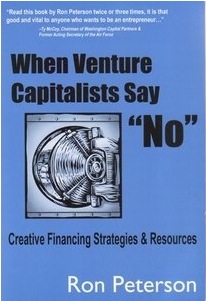 While researching trends in longevity and their significance for start-up companies, I came across an extraordinary report by investment banker Ronald Peterson. Entitled “Technology Transfer and the Life-Sciences,” the report is chock-full of two things:
While researching trends in longevity and their significance for start-up companies, I came across an extraordinary report by investment banker Ronald Peterson. Entitled “Technology Transfer and the Life-Sciences,” the report is chock-full of two things:
1. Examples of companies who have licensed technology, then made a fortune off it.
2. Contact information for anyone pursuing similar ambitions.
A veteran venture capitalist, Peterson thinks it is too slow and too risky for biotechnology companies to develop their own proprietary technology:
Arguably the best way to form a new biotechnology company (or any technology company for that matter) is to transfer a technology that has already been largely developed and form a company by adding management, marketing and other needed talent.
Peterson’s formula for success is basically the blueprint for a Minitrends Adventure. First, locate a technology to exploit. Peterson provides links to dozens of sources, including exchanges where universities list thousands of technologies available for licensing. Next, attach that technology to your own entrepreneurial marketing team. Third, fund the operation with venture capital.
While venture capital is tight these days, it is not impossible to find. Peterson wrote a book in 2003 on how to find venture capital when markets are tight. The book is currently out of print, but available used through Amazon and other retailers. It’s called When Venture Capitalists Say “No”: Creative Financing Strategies and Resources.
Technology Transfer (TT) — the Minitrends route Peterson recommends — is also a winning strategy for the organizations that license their inventions to entrepreneurs. A study by the Milken Institute shows that universities reap $6 million in licensing fees for every $1 million spent on technology transfer operations.
This amazing article by Peterson, which is as long as a book, contains resource after resource, plus example after example to get you inspired. For example, Neven Vision licensed face recognition technology developed at the University of Southern California, secured $200,000 in venture capital funding, and later sold the firm to Google for $40 million. If this article doesn’t get your entrepreneurial blood boiling, you must be in cryonic suspension.
Ronald Peterson is president of Three Arrows Capital Corp., a U.S. investment banking firm that has helped fund hundreds of emerging high-growth companies. He has over 30 years of experience on Wall Street as either a vice-president or registered representative with companies such as Merrill Lynch and Paine Webber. He can be reached at Three Arrows Capital, 7517 Westfield Drive, Suite A, Bethesda, MD 20817; 301-229-6240; fax: 301- 229-5462; email: tarrows@comcast.net.
STEVE O’KEEFE
News Editor, Minitrends Blog
Source: “Technology Transfer and the Life-Sciences,” by Ron Peterson, 01/01/08
Cover image of When Venture Capitalists Say “No”: Creative Financing Strategies and Resources is used under Fair Use: Reporting.
From Fashion Trends to Nanotech Trends with The Wall Street Journal
September 30, 2010

After enduring “Fashion Week” taking over the pages of The Wall Street Journal, culminating in The Journal‘s brief and scary transformation to WSJ last weekend, I was beginning to look for another daily source of technology news. The Journal has always been good at spotting tech trends. The “newspaper of record for business” redeemed itself with a special report Monday on The Journal’s 2010 Technology Innovation Awards.
Many of the dozens of winners and runners-up were nanotechnology companies. Echoing my previous report on nanotechnology in water treatment projects, The Wall Street Journal bestowed the Environmental Award to NanoH2O, Inc., for “a nanotechnology-based, reverse-osmosis membrane that promises to reduce the cost of running a typical desalination plant by as much as 25%.”
Many of the awards went to filtration systems, the ones that clean water or clean computers, and those that can turn our waste into useful products in particular. The winner of the Energy Award is InEnTech, LLC, for a plazma gassification process for generating fuel from municipal and industrial waste.
The Gold Winner was a think tank in Taiwan, the Industrial Technology Research Institute (ITRI), which won the award for an elegant process for making thin, flexible video displays. The Wall Street Journal‘s San Francisco news editor, Michael Totty, says the idea for the paper-thin process came from watching pancakes being made. You never know where those Minitrends will strike you!
Better video walked away with the Semiconductor Award as well. InVisage Technologies, Inc., won the award for sensors in digital cameras that use “semiconducting nanocrystals” to collect much more light than digital cameras using silicon sensors. The result:
The product, InVisage says, captures more than 90% of available light, compared with 25% for a silicon-based sensor.
Cambrios Technology Corp. also got a nod from The Wall Street Journal. The company was listed as a runner-up for the Materials Award for a coating of nanowires that makes possible a cheaper, more flexible, touch-sensitive coating for touch screens.
Here we have four winners, and four different approaches to capitalizing on developments in nanotechnology. The book, MINITRENDS, has an excellent chapter devoted to trends in nanotechnology, including water purification and fake bone!
Many of these nanotechnology breakthroughs will become profitable in the next two to five years, making them classic “Minitrends.” For a look a little further into the future, The Wall Street Journal interviewed Francis Collins, director of the National Institute of Health, about nanotechnology in healthcare:
[M]edicine is about to redefine ‘minimally invasive,’ says Francis Collins… ‘The drug-delivery devices are small enough to fit through a hypodermic needle.’
The Wall Street Journal will honor this year’s Innovation Award winners at the FASTech conference in Redwood City, California, on Wednesday and Thursday, November 3 and 4. The event promises to be a schmoozefest, with entrepreneurs courting venture capitalists and investment bankers, and everyone mugging for the media. It should be a good venue for bagging some Minitrends. Happy Hunting!
by STEVE O’KEEFE
News Editor, Minitrends Blog
Source: “The WSJ Technology Innovation Awards,” The Wall Street Journal, 09/27/10.
